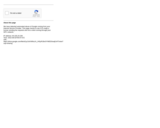
End of World War II - Grade 5
- Subject:
- Social Science
- Material Type:
- Lesson Plan
- Date Added:
- 08/01/2022

End of World War II - Grade 5
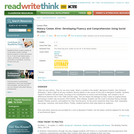
Let the power of imagination and inference serve as a ńtime machineî to bring Benjamin Franklin into the classroom! History and science come to life in a dialogue with Franklin the inventor, developed through lesson activities that incorporate research, imagination, writing, visual arts, and drama.
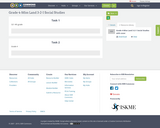

The K-5 Classroom Resource list is intended for use by educators with students. Background texts and resources for professional development are also available. Please contact Social Science Specialist Amit.Koborowski@state.or.us for more information.

The necessity of teaching LGBTQ history has never been more apparent than in the current political climate. Over the past year, hundreds of anti-LGBTQ laws have been proposed across the country. Several have specifically attempted to prohibit teaching about these topics. California educators remain committed to an inclusive curriculum and continue to lead the charge modeling best practices in teaching LGBTQ history.
But, the path has not always been clear. When California educators started to implement this flagship law, SB48, otherwise known as the FAIR Act, which called for inclusion of LGBTQ Americans in U.S. history courses at the K-12 level, so many questions arose. Most of the discussion has centered around how to make our curriculum more inclusive while efficiently managing our limited instructional time.
One of the key issues has been about whether to create stand-alone or integrated lessons. Stand-alone lessons are significant because they allow students to do a deep dive into a specific topic. This can be useful when addressing big issues in the LGBTQ past. Here are a few examples of lessons that do just that:
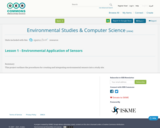
This project outlines the procedures for creating and integrating environmental sensors into a study site.

Book List Topics:Identity MattersAmerican Indian VoicesVoices Around the WorldInclusive VoicesBoundary BreakersExpanding the Narrative
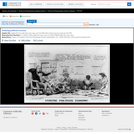
A crudely drawn but complex satire mocking Zachary Taylor's military background and lack of political experience. Student Zachary Taylor, wearing a paper cap made out of the journal "The True Whig" is seated on a low stool at the feet of his more politically seasoned running mate Millard Fillmore. Taylor reads from a book "Congressional Debates 1848. Slavery . . .", and spells out "W-I-L-M-O-T: Wilmot, P-R-O-V-I-S-O: Proviso. What do I know about such political stuff. Ah! Wait until I get loose, Then you will see what fighting is!" A torn sheet marked "National Bank" lies at his feet. Fillmore, who reads from "The Glorious Whig Principles [by] Henry Clay," admonishes Taylor, "This will never do, you must forsake this course,--for our party is a peaceful and rightous sect--free from wickedness." Behind Fillmore are an open book cabinet, the Constitution, and a globe. This are in obvious contrast to the maps of "The Late War" and a broadsheet "The Life of Johnny Tyler" on the wall behind Taylor. At Taylor's knee sits a bloodhound with a collar marked "Florida," a reminder of Taylor's controversial use of bloodhounds in the Second Seminole War. To the right two black youths polish Taylor's weapons. The first, kneeling and wiping a pistol, says, "By golly! Massa Taylor like fighting better then him dinner." The other, cleaning a sword, claims, "Dis am de knife wot massa use to cut up de Mexijins wid." In the center of the floor are a group of toy soldiers and a cannon.|Probably drawn by E.F. Durang.|Published by Peter E. Abel & Durang, Philada.|Sold by Turner & Fisher, N. York & Philada.|Title appears as it is written on the item.|Weitenkampf, p. 95.|Forms part of: American cartoon print filing series (Library of Congress)|Published in: American political prints, 1766-1876 / Bernard F. Reilly. Boston : G.K. Hall, 1991, entry 1848-44.
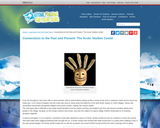
This article describes online artifact collections available through the Arctic Studies Center, a part of the Smithsonian's National Museum of Natural History. The collection includes artifacts and background information about the peoples of Alaska and Northeast Siberia.

The 11 books selected for inclusion in the issue of Beyond Weather and the Water Cycle devoted to climate studies range from easy readers to biographies. Each book is briefly described; all were reviewed for accuracy and appropriate reading levels for students in grades K-5. Several books deal with careers in meteorology.
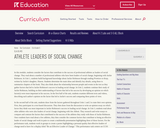
Grade 5: Module 3 of the EL Education K-8 Language Arts Curriculum. In this module, students build their literacy and social-emotional skills through the analysis of literary and informational texts, as they engage in a study of athlete leaders of social change. For more information on getting started with the curriculum, please visit https://curriculum.eleducation.org.
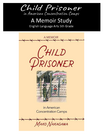
Japanese American Memorial Pilgrimages has developed lessons, supplemental resources, and educational documentary videos to accompany the memoir Child Prisoner in American Concentration Camps by Mako Nakagawa.
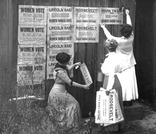
In this focused inquiry, students investigate the question: Are rights “granted” or “won?”. They will also consider: How did women rally support for the vote when they couldn’t vote themselves? What methods were used to gain the right to vote in Washington?
Students will engage in deep reading, develop summaries of information, conduct independent research, and engage in small and large group discussions and write an argument with a well-formed claim, clear evidence, and reasoning.
Photo of Washington Equal Suffrage Association posting signs to promote woman suffrage, Seattle by Curtis Asahel | Washington State Digital Archives. This image is made available for use in research, teaching, and private study.
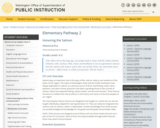
Salmon play an important role in the ways of life, culture, history, and resilience of the tribes of this region. The tribes of Washington State and the Pacific Northwest have always depended on salmon as a primary source of food. Overfishing, roads, dams, pollution, and other human practices have been a growing threat to the survival of salmon, which has impacted fishing, salmon-eaters, and the environment. These lessons introduce to children the role of salmon in the history and culture of the first peoples of our region.
The Honoring the Salmon lessons are designed to be taught as a series but can also be taught individually, adapted for each grade level, K-3. They can easily be integrated into science units on salmon, water or watersheds. Content knowledge from these lessons can provide background knowledge for 3rd grade and 4th grade Social Studies CBAs.
NOTE: These lessons are designed around fiction and non-fiction books that are not a part of the STI curriculum. Most of them are easily available through public libraries. Some may need to be purchased.
These lesson resources align to additional Washington State Social Studies, English Language Arts, Environmental and Sustainability, and Social Emotional Learning standards. A full standard curriculum document is included at the bottom of the Pathway 2 introduction page.
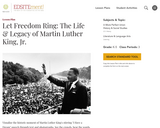
Students listen to a biography of Martin Luther King, Jr., view photographs of the March on Washington, and study King's use of imagery and allusion in his "I Have a Dream" speech.
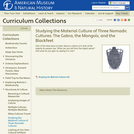
In this Moveable Museum lesson plan, students examine cultural artifacts from three different nomadic cultures, first on their own, and then in contextual photographs, gaining insight into the work of anthropologists. The 13-page PDF guide has educator materials including background information, teacher strategies, assessment guidelines, and detailed notes about the curriculum standards addressed. The Everyday Objects activity worksheet has isolated photographs of three cultural artifacts, with information on their materials and size. The Objects in Context activity worksheet has photographs of each object with explanatory text (object name, culture, use, and significance). The Putting It All Together activity has a list of discussion questions to help students further investigate material culture.

Holocaust education is history, literature, social studies, psychology, art, and so much more. By studying the Holocaust we learn the importance of speaking out against bigotry and indifference, promoting equity, and taking action. Studies show that Holocaust education both improves students' critical thinking skills and encourages "upstander" behavior: willingness to act upon civic awareness and confront hatred in all its forms. On this site you're going to find lessons that adhere to the requisite guidelines for teaching about the Holocaust and Genocide, with options for in-person and remote instruction. Each Overview Lesson includes:Historical summarySurvivor video clipsDiscussion questionsCommon Core State Standards addressed in that lesson

In this Moveable Museum lesson plan, students write a research proposal, drawing on their knowledge of a nomadic culture. Then they submit their proposals to you - the governing agency that determines what fieldwork will be supported. The 12-page PDF guide has educator materials including background information, teacher strategies, assessment guidelines, and detailed notes about the curriculum standards addressed. The Writing the Research Proposal activity worksheet has six questions designed to guide students' research and help them gather the information needed for their proposals.

The ILLUMINE YouTube channel (https://www.youtube.com/@illumineproject) hosts videos for classroom use (stress mindsets) and video case studies presented by teachers from each of the partner countries (Spain, Portugal, Serbia, Estonia).
There are 9 video case studies presented by teachers and 12 stress mindset videos (2 in each partner language) created to support the conceptual replication of an evidence-based practice (Stanford research study).
ILLUMINE helps school teachers design more effective learning experiences by having teachers conduct research lessons and share their findings with the educational community. ILLUMINE’s teacher inquiry grounded approach aims to increase teacher use of evidence-based strategies with technology, understanding of science of learning theory (cognitive neuroscience), and collaboration with peers.
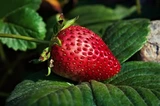
Integrated ELA and Social Studies Unit incorporating Washington State's Since Time Immemorial content. Students learn native values in plant care, the oral tradition of storytelling and share and celebrate their learning.